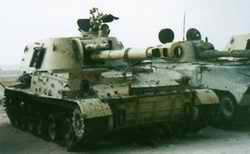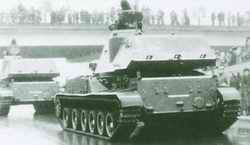| Designation: | 2S3 Akatsia |
 |
|---|---|---|
| Manufacturer: | Uraltransmash Works | |
| Product type: | Armoured Vehicles | |
| Name: | Self-propelled gun |
The requirement for the 152 mm 2S3 Akatsiya (Acacia) self-propelled artillery system was drawn up in July 1967 with Uralmash being responsible for the 152 mm weapon and UZTM in Sverdlovsk responsible for the full-tracked chassis.
The 152 mm ordnance of the 2S3 was ballistically identical to that used for the 152 mm D-20 towed artillery system and used the same ammunition. The new 152 mm gun had the factory designation of the D-22 and the industrial designation of the 2A33.
The full-tracked chassis was developed under the designation of the Obiekt 303 and was a further development of the Obiekt 123 used for the Krug (SA-4 Ganef) surface-to-air missile system. The chassis was upgraded in many areas including the installation of a more powerful 520 hp diesel engine. The track and torsion bar suspension were also upgraded.
The first two prototypes of the 2S3 were completed by late 1968 and testing continued through to 1969 but problems were encountered with contamination in the turret so an additional four improved systems were built. The system was accepted for service in December 1971 although production had commenced the previous year. Until its correct designation of 2S3 Akatsiya became known it was referred to in the West as the 152 mm M1973. The M1973 indicates the year that it was first observed.
It was originally issued on the scale of 18 per tank division and 18 per motorised rifle division and has now replaced the older towed 130 mm Field Gun M-46 in the former Russian Army artillery brigades and artillery divisions. The 2S3 is normally deployed in batteries of six weapons, with three batteries making up a regiment.
It is estimated that well over 10,000 of these systems were manufactured, although no production figures have been released.
Production of the 2S3 was completed some years ago and its replacement is the more recent 152 mm self-propelled artillery system 2S19. Due to the reduction in the overall size of the Russian Army, numbers of weapons are becoming available for sale including quantities of artillery systems such as the 2S3.
The chassis of the 152 mm 2S5 self-propelled gun shares many common components with the 2S5 chassis and is also referred to as the Izdeliye 303.
The all-welded steel hull of the 2S3 self-propelled gun-howitzer is divided into three compartments: driver's at the front on the left, engine to the right of the driver and the fully enclosed turret at the rear. The driver has a single-piece hatch cover that opens to the rear. In front of this are two day periscopes, the left one of which can be replaced by an infra-red device (or, more recently, a passive device) for driving at night. The driver has an adjustable seat and under this is an emergency hatch. On the forward part of the glacis is a splashboard to stop water rushing up the glacis plate when the vehicle is fording a stream. The air-inlet and air-outlet louvres are on the top of the hull, with the exhaust outlet on the right side of the hull, just above the track guard.
The large all-welded steel armour turret has a sloped front and well-sloped sides with a vision block in each side. The commander is seated on the left of the turret with the gunner forward and below him and the loader on the right. The commander has a cupola that can be traversed through a full 360° and a single-piece hatch cover opening to the rear. Vision devices are provided around the lower part of the cupola. Including a TKN-3A device. Mounted on the forward part of the hatch is a 7.62 mm PKT machine gun which can be aimed and fired from inside the turret. There is an OU-3K infra-red/white light searchlight mounted to the left of the 7.62 mm PKT machine gun.
Gunlaying, including firing, is accomplished by the gunner. In addition to the PG-4 sight there is an OP5-38 gunner's telescope. Cants of up to 5° in pitch and roll axes can be offset.
The panoramic telescope has a 10.5° field of view and ×3.7 magnification. The OP5-38 gunner's telescope has an 11° field of view, a magnification of ×5.5 and is normally used for direct fire engagements.
Turret traverse and weapon elevation/depression are powered, with manual controls for emergency use.
The loader feeds the projectiles and charges to the ordnance via a loading tray with a chain-driven rammer used to seat the projectile and then the charge in the chamber.
The loading mechanism is lowered when the gun is fired. The breech opens automatically.
In the rear half of the hull are 33 projectiles, complete with fuzes, which are stowed in three horizontal layers.
On the 2S3M/2S3M1 is a projectile carousel that holds an additional 12 projectiles in the vertical position.
As each round is fired the carousel automatically revolves 30° so positioning the next projectile.
Stowed below the projectiles are 16 charges in two layers of eight with an additional eight being stowed near the loader's position and more being stowed in brackets in the vehicle. An ammunition resupply hatch is provided in the right side of the turret and there is an oval hatch at the rear of the hull that opens downwards.
Wherever possible, 152 mm ammunition would be used from outside the 2S3 with the onboard ammunition supply being retained ready for immediate use.
The two ammunition members are in a 6 × 6 truck and, on arriving at the fire position, one of these plugs into the external connector of the 2S3's intercom system at the rear and listens into the firing commands. The prepared 152 mm projectiles (complete with set fuze) and charge are then passed through the circular openings in the rear of the vehicle. The later 2S3M/2S3M1 has a single opening.
Main armament comprises a 152 mm weapon, designated the 2A33, which is based on the towed 152 mm D-20 gun-howitzer but with a bore evacuator added behind the muzzle brake. Production of the 152 mm 2A33 ordnance was undertaken by the Motovilkha Plants Corporation. The barrel has a double-baffle muzzle brake, fume extractor and a gun barrel travelling lock. This is operated by the driver, from the driving position, without leaving the vehicle.
The normal projectile fired by the 2S3 is the HE-FRAG OF-540, which is fitted with an RGM-2 fuze, weighs 43.5 kg, contains 5.76 kg of TNT, has a maximum muzzle velocity of 655 m/s and a maximum range of 18,500 m. Other types of projectile fired include BP-540 HEAT-FS (also referred to as HEAT-SS, for spin-stabilised), HE/RAP (High-Explosive Rocket-Assisted Projectile) with a range of 24,000 m, AP-T, illuminating, smoke, incendiary, flechette, scatterable mines (anti-tank and anti-personnel) and the Krasnopol laser-designated projectile covered in the entry for the 152 mm 2S19. The 152 mm gun has an elevation of +60° and a depression of -4°. Turret traverse is a full 360°.
The torsion bar suspension consists of six dual rubber-tyred road wheels each side with the drive sprocket at the front, idler at the rear and four track-return rollers. The first and last return rollers support the inside of the track only. The first, second and sixth road wheel stations have a hydraulic shock-absorber and there is a distinct gap between the first and second and second and third road wheels.
The 2S3 has infra-red night vision equipment and an NBC system. According to Russian sources, the NBC system also keeps the turret clear of fumes when the gun is fired. An OV-65G heating unit is also fitted. It has no amphibious capability and normally carries an unditching beam at the rear of the hull.
Most 2S3 systems have an entrenching blade mounted at the front of the hull to enable the system to prepare its own fire position without engineer support. This enables the 2S3 to prepare its own firing position in between 20 and 40 minutes depending on the type of terrain.
Command and control of the 2S3 series is provided by the 1V12 series of vehicles based on the MT-LBu series full-tracked vehicle covered in detail in a separate entry.
Late production versions of the 2S3 are designated the 2S3M and 2S3M1. The 2S3M and 2S3M1 have an ammunition load of 40 projectiles and charges and also a loading carousel which facilitates loading and therefore increases the rate of fire.
These versions can be distinguished from the rear as they have two small stowage compartment covers positioned to the right and left of the hull rear as opposed to a larger oval cover in the centre.
The 2S3M1 is, in addition, equipped with a data terminal which automatically displays the fire command transmitted to the battery officer's upgraded 1V13M command vehicle. It also has an IP-5 sight.
More recently, Russia has offered a modernised version of the 2S3M1 with a much longer 152 mm barrel. This fires a standard HE projectile to a maximum range of 20,550 m or a HE base bleed projectile to a maximum range of 23,900 m.
Specifications are similar to the standard system but combat weight is 27,800 kg while overall length with ordnance in travelling lock is 9.48 m.
- 152 mm 2S3M2
For several years Uraltransmash Federal State Unitary Enterprise in Ekaterinburg, Russia, has been working on a number of enhancements to the 152 mm 2S3 which originally entered service in the early 1970s.
The standard 2S3M has a 152 mm/28 calibre barrel designated the 2A33 but the company is now offering two further enhancements to bring the system up to the 2S3M2 or 2S3M3 standard.
As production of the complete 2S3 series systems was completed some time ago, these upgrades are being offered to existing customers. The upgrades could be carried out by Uraltransmash but it would be most cost effective for the company to provide kits to enable the user to upgrade existing systems in their own facilities.
In the 2S3M2 version the 152 mm/28 calibre barrel is replaced by a new 152 mm/39 calibre barrel which, firing a 3OF61 high-explosive base-bleed projectile enables a maximum range of 25.1 km. It can also fire the KBP Krasnopol laser-guided artillery projectile which is also manufactured in 155 mm calibre and which has been sold to China, France and India.
- 155 mm 2S3M3
The 2S3M3 features a western type 155 mm/39 calibre barrel which fires standard NATO types of ammunition. Firing the old 155 mm United States M107 high-explosive projectile a maximum range of 18.2 km is achieved.
Firing the German/Italian/UK L15A1 high explosive, a range of 24.7 km is quoted while firing the US M549A1 rocket-assisted projectile a maximum range of 30 km is quoted. It can also fire the 155 mm Krasnopol-M laser-guided projectile out to 17 km.
As far as it is known, the 155 mm version remains at the prototype stage.
- Automated Fire Control System
Russia is now marketing a new Automated Fire Control System (AFCS) that can be integrated into self-propelled artillery systems such as the full tracked 152 mm 2S19, 152 mm 2S3 and 122 mm 2S1 as well as multiple rocket launchers such as the 122 mm BM-21 multiple rocket launcher. Full details of this are provided in the entry for the Russian 152 mm 2S19 self-propelled artillery system.
|
||||||||||||||||||||||||
|
||||||||||||||||||
|
||||||||||||||||||||||||||||||||||||||||||
Related Articles |
|
Russia-Belarus military & technical cooperation (18.05.2005) |
 |
 |
 |
 |











